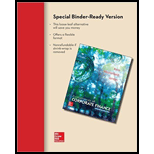
Fundamentals of Corporate Finance (Special Edition for Rutgers Business School)
11th Edition
ISBN: 9781308509853
Author: Ross, Westerfield, Jordan
Publisher: McGraw Hill
expand_more
expand_more
format_list_bulleted
Question
Chapter 2.1, Problem 2.1ACQ
Summary Introduction
To discuss: The meaning of
Introduction:
Balance sheet refers to the statement that indicates the financial position of a firm. The statement helps to understand the amount of assets, liabilities, and shareholders’ equity of the firm. The balance sheet has two sides namely assets and liabilities.
The assets include the current assets and long-term assets of the firm. The liabilities include the current liabilities, long-term liabilities, and the shareholders’ equity. The liabilities side of the balance sheet always equals the assets side of the balance sheet.
Expert Solution & Answer
Want to see the full answer?
Check out a sample textbook solution
Students have asked these similar questions
QUESTION 1
Examine the information provided below and answer the following question.
(10 MARKS)
The hockey stick model of start-up financing, illustrated by the diagram below, has received a lot of attention in the
entrepreneurial finance literature (Cumming & Johan, 2013; Kaplan & Strömberg, 2014; Gompers & Lerner, 2020). The model
is often used to describe the typical funding and growth trajectory of many startups. The model emphasizes three main
stages, each of which reflects a different phase of growth, risk, and funding expectations.
Entrepreneur, 3 F's
Debt(banks & microfinance)
Research Business angels/Angel Venture funds/Venture capitalists
Merger, Acquisition
Grants
investors
PO
Public market
Growth (revenue)
Break even
point
Pide
1st round
Expansion
2nd round
3rd round
Research
commercial idea
Pre-seed
Initial concept
Seed
Early
Expansion
Financial stage
Late
IPO
Inception and
prototype
Figure 1. The hockey stick model of start-up financing (Lasrado & Lugmayr, 2013)
REQUIRED:…
critically discuss the hockey stick model of a start-up financing. In your response, explain the model and discibe its three main stages, highlighting the key characteristics of each stage in terms of growth, risk, and funding expectations.
Solve this problem please .
Chapter 2 Solutions
Fundamentals of Corporate Finance (Special Edition for Rutgers Business School)
Ch. 2.1 - Prob. 2.1ACQCh. 2.1 - What is liquidity? Why is it important?Ch. 2.1 - What do we mean by financial leverage?Ch. 2.1 - Explain the difference between accounting value...Ch. 2.2 - What is the income statement equation?Ch. 2.2 - Prob. 2.2BCQCh. 2.2 - Why is accounting income not the same as cash...Ch. 2.3 - What is the difference between a marginal and an...Ch. 2.3 - Do the wealthiest corporations receive a tax break...Ch. 2.4 - Prob. 2.4ACQ
Ch. 2.4 - Prob. 2.4BCQCh. 2.4 - Why is interest paid not a component of operating...Ch. 2 - What types of accounts are the most liquid?Ch. 2 - What is an example of a noncash expense?Ch. 2 - The marginal tax rate is the tax rate which...Ch. 2 - Prob. 2.4CTFCh. 2 - Prob. 1CRCTCh. 2 - Accounting and Cash flows [LO2] Why might the...Ch. 2 - Prob. 3CRCTCh. 2 - Operating Cash Flow [LO2] In comparing accounting...Ch. 2 - Prob. 5CRCTCh. 2 - Cash Flow from Assets [LO4] Suppose a companys...Ch. 2 - Prob. 7CRCTCh. 2 - Net Working Capital and Capital Spending [LO4]...Ch. 2 - Prob. 9CRCTCh. 2 - Prob. 10CRCTCh. 2 - Prob. 11CRCTCh. 2 - Earnings Management [LO2] Companies often try to...Ch. 2 - Building a Balance Sheet [LO1] KCCO, Inc., has...Ch. 2 - Building an Income Statement [LO1] Billys...Ch. 2 - Dividends and Retained Earnings [LO1] Suppose the...Ch. 2 - Prob. 4QPCh. 2 - Calculating Taxes [LO3] The Dyrdek Co. had 267,000...Ch. 2 - Prob. 6QPCh. 2 - Calculating OCF [LO4] Ridiculousness, Inc., has...Ch. 2 - Calculating Net Capital Spending [LO4] Bowyer...Ch. 2 - Calculating Additions to NWC [LO4] The 2014...Ch. 2 - Cash Flow to Creditors [LO4] The 2014 balance...Ch. 2 - Cash Flow to Stockholders [LO4] The 2014 balance...Ch. 2 - Prob. 12QPCh. 2 - Market Values and Book Values [LO1] Klingon...Ch. 2 - Prob. 14QPCh. 2 - Using Income Statements [LO1] Given the following...Ch. 2 - Preparing a Balance Sheet [LO1] Prepare a 2015...Ch. 2 - Prob. 17QPCh. 2 - Prob. 18QPCh. 2 - Net Income and OCF [LO2] During 2014, Raines...Ch. 2 - Prob. 20QPCh. 2 - Prob. 21QPCh. 2 - Calculating Cash Flows [LO4] Consider the...Ch. 2 - Net Fixed Assets and Depreciation [LO4] On the...Ch. 2 - Prob. 24QPCh. 2 - Use the following information for Taco Swell,...Ch. 2 - Use the following information for Taco Swell,...Ch. 2 - Prob. 1MCh. 2 - Prob. 2M
Knowledge Booster
Similar questions
- Take value of 1.01^-36=0.699 . step by steparrow_forwardsolve this question.Pat and Chris have identical interest-bearing bank accounts that pay them $15 interest per year. Pat leaves the $15 in the account each year, while Chris takes the $15 home to a jar and never spends any of it. After five years, who has more money?arrow_forwardWhat is corporate finance? explain all thingsarrow_forward
arrow_back_ios
SEE MORE QUESTIONS
arrow_forward_ios
Recommended textbooks for you
- Century 21 Accounting Multicolumn JournalAccountingISBN:9781337679503Author:GilbertsonPublisher:CengagePrinciples of Accounting Volume 1AccountingISBN:9781947172685Author:OpenStaxPublisher:OpenStax College
 Intermediate Accounting: Reporting And AnalysisAccountingISBN:9781337788281Author:James M. Wahlen, Jefferson P. Jones, Donald PagachPublisher:Cengage Learning
Intermediate Accounting: Reporting And AnalysisAccountingISBN:9781337788281Author:James M. Wahlen, Jefferson P. Jones, Donald PagachPublisher:Cengage Learning

Century 21 Accounting Multicolumn Journal
Accounting
ISBN:9781337679503
Author:Gilbertson
Publisher:Cengage


Principles of Accounting Volume 1
Accounting
ISBN:9781947172685
Author:OpenStax
Publisher:OpenStax College

Intermediate Accounting: Reporting And Analysis
Accounting
ISBN:9781337788281
Author:James M. Wahlen, Jefferson P. Jones, Donald Pagach
Publisher:Cengage Learning